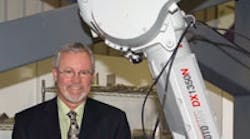"In their early days robots were more limited by their controller technology than by their physical capabilities," explains Roger Christian, vice president marketing and international groups with robot producer Motoman, noting the growing presence of machining robots where CNC machine tools once performed alone. "Robot designs that have emerged in the 21st century are mechanically faster, stronger and more accurate, but controller technology is just beginning to catch up," he says.
"It is only in the last three or four years that the control has evolved to where it needs to be to facilitate the ability of a robot to act as a machine tool," Christian adds, noting that the problem centers on the lack of standardization with how controllers communicate. Each robot company, he observes, has evolved a proprietary language.
"Robot arms are generally moved to points along a path or from place to place via a teach pendant. Basically an operator will push a button to move the arm in a certain direction, and then when the arm gets to where it needs to be, a push of a button records locations along that linear or circular path. That manual process is acceptable for such things as when you're picking and placing or welding," explains Christian.
"But manually programming the robot controller for machining becomes an arduous task. Very complex paths have to be followed which become an overwhelmingly difficult process, one that is too time-consuming to program by hand," he says.
In contrast, part generation via machine tools can reap the process benefits of CAD/CAM software. CAD facilitates part design while conventional CNC machine tools read G-Code generated through the conversion programs of the CAM software.
Unlike the brand-specific languages of robots, G-Code is a universal language of machine tool programming. It defines the tool path, the tool offset, the angles of the tool and the speed of the tool.
User interest in robotic machining traditionally relates to the low equipment investment required, says Christian. For example, one of today's robots can be purchased for a fourth or a third of the cost of a machine tool. (His comparison: a $75,000 robot with a $250,000 machine tool.)
For example, Motoman resolves the problem with a software solution called G-Code Converter EG. "What we can do," says Christian, "is start with a part that is defined in CAD/CAM programs to automatically generate robot programs off-line. We can also take standard machine tool languages and convert them into a robot program language, automatically."
He says a G-Code program with as many as 30,000 points can be used to generate a robot program in as little as 10 minutes, depending on the speed of the user's PC. The software is designed to automatically translate large processes into multiple subroutines that a robot can perform and allows mapping of custom machine functions to standard robot functions.
The PC-based application software uses standard G-Code programs used by CNC machine tools, including I/O and other non-motion commands, to generate production robot programs. As a result, users can minimize the time required to program robot systems to perform many of the diverse applications that previously necessitated CNC-equipped machine tools. That opens up new opportunities for machining with robots. One emerging example is job shops, Christian notes, "where lengthy programming is incompatible with their typical rapid succession of short-run jobs."
Christian says the G-Code Converter allows users to optimize their use of capital by utilizing standard applications involving cutting, deburring, trimming, engraving, drilling and tapping, mold creation and surface finishing. But he is careful to note that the product strategy is to augment, not replace machine tools in the machining of metal. He also positions the G-Code Converter software as a means of extending the low-cost value of robots toward the CNC machining of softer materials, such as wood, fiberglass, foam for molds and prototype mold work. "These are materials where a lot of milling and profiling has been historically done on machine tools."
Christian says Motoman's software achievement is in the ability to take G-Code information and convert it into robot programming language offline. "Now we can take standard machine tool languages and convert them into a robot program language automatically." He says the software can be configured to interpret a wide range of individual G-Code file formats, including SURFCAM, Gibbs-CAM and Delcam.
I/O and other commands contained in standard M and G Codes can also be adjusted for CNC to robot variations. Mapping of user machine functions is performed using an XML configuration file. Christian says the G-Code Converter allows the user to set default robot configurations, speeds, motion types and reference frames in the configuration file as well.
The software is an add-on module available for the MotoSim Points Importer.
See Also
- Allocating Responsibility for Manufacturing Cost
- Rethinking Supplier Relationships with Tool Providers
- Bookshelf: The Necessary Revolution: How Individuals and Organizations Are Working Together to Create a Sustainable World
- Bookshelf: The Innovator's Guide To Growth: Putting Disruptive Innovation To Work



